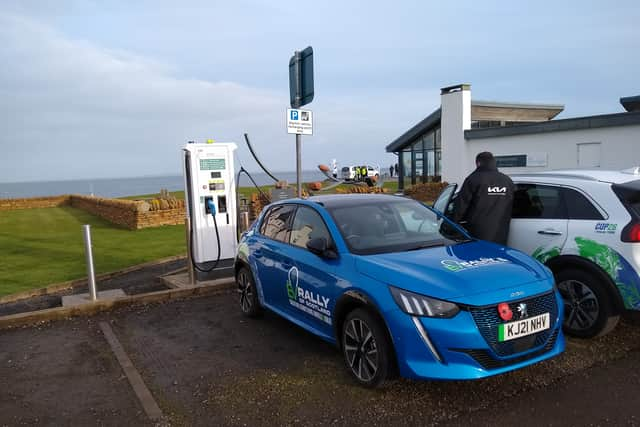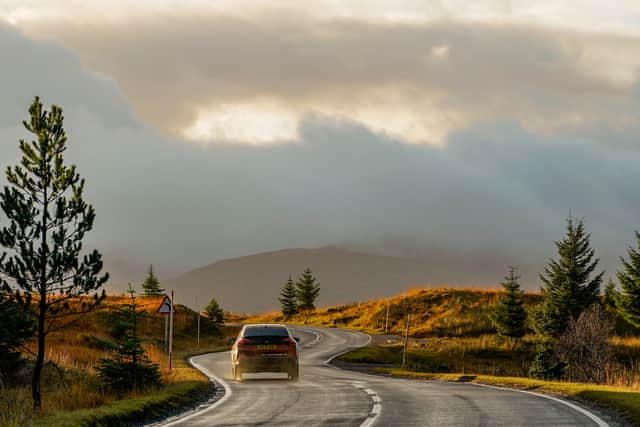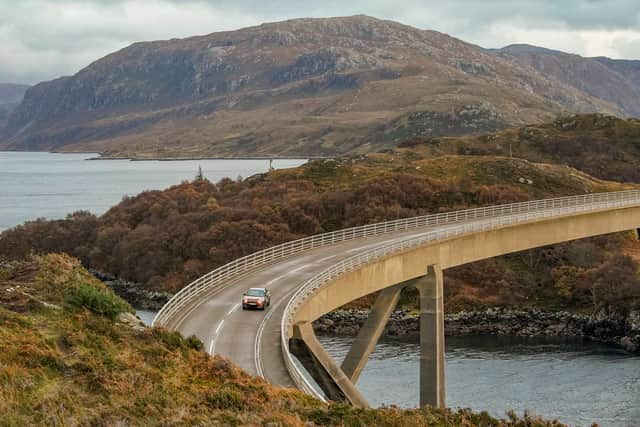Searching for the positives on an EV tour of Scotland
and live on Freeview channel 276
No plan survives first contact with the enemy, so goes the old military adage.
In my case the “enemy” was the flaky EV charging infrastructure around Inverness which scuppered what should have been an easy leg of the inaugural EV Rally of Scotland (EVRoS).
Advertisement
Hide AdAdvertisement
Hide AdThe plan wasn’t complicated. Get our Peugeot e-208 from Thurso to Aberdeen via John o’ Groats and Loch Ness, reaching the Granite City in time for me to catch an evening train.
Compared with the gruelling 320-mile leg the previous day, the 250-mile run through Caithness and Sutherland with their easy roads and more generous charger provision should have been a doddle but issues at multiple chargers meant I eventually had to abandon my car and co-driver at Inverness Castle and hitch a lift with the AA support crew to catch my train.
Had I not had to make that train I could undoubtedly have completed day four of the rally eventually. Indeed, my co-driver did finish it, but he didn’t reach the final checkpoint in Inverurie until nine and a half hours after setting off from John O’Groats - a journey that, even with a stop for charging, should have taken six hours.
The EVRoS was conceived to showcase the qualities of electric cars, such as our Peugeot, and demonstrate the capabilities of Scotland’s charging infrastructure. It certainly did, although not always in the best light.
Advertisement
Hide AdAdvertisement
Hide AdIn fairness, I undertook the toughest two days of the rally and colleagues who completed loops around the Central Belt and between Aberdeen and Glasgow reported plenty of charging hubs with multiple high-speed units. But in lesser-populated areas, the experience proved how far we still have to go in developing a network capable of supporting mass EV adoption.
Thursday’s plan had been straightforward. Head from the hotel to John o’ Groats, grab a quick top-up while we took part in a Remembrance ceremony, then on the road for 150 miles or so before a stop somewhere around Inverness. One single big charge of our e-208’s 50kWh battery would then see us through to Aberdeen, with a handful of back-up options en route.


The first part worked like a charm and we left the famous signpost with 180 miles of predicted range. Our sedate run at 4 miles/kWh even instilled a confidence that we could reach Inverness with battery to spare so we breezed past several potential charge points “safe” in the knowledge that we had a number of rapid DC charging stations to choose from once we reached checkpoint two at Inverness Castle.
Sadly, in the space of 45 minutes spent dotting around the city, we couldn’t find one working, unoccupied unit. The first in the shadow of Inverness Caledonian Thistle’s main stand was refusing to work for either the Polestar 2 or Kia EV6 parked beside it. A quick check of the ChargePlace Scotland app suggested the Highland Council HQ, where we discovered a rank of slow AC chargers all occupied.
Advertisement
Hide AdAdvertisement
Hide AdNever fear, the app assured us that 10 minutes away, the 50kW DC unit at Raigmore Hospital was working and free. Half an hour there would see us topped up enough to get on our way and hopefully complete our checkpoints.
Rolling into the car park, we found another e-208 owner on the phone trying to get the faulty charger reactivated. The engineers managed to restart the unit remotely but at a painfully slow 12kW rather than the advertised 50kW. With the other owner in for a long charge to get him to Glasgow we pressed on, hoping that the final rapid unit in the city centre was free. It was. But only because it wasn’t working either.


By this point, with a three-and-a-half hour drive to Aberdeen, just 20 miles of charge and a little over four hours until I had to be on a train, I had to abandon my co-driver to his fate and hitch a ride with the AA in their diesel Ford Kuga.
There’s no doubt that a simple decision here or there could have changed our day. Had we chosen to stop and charge with 80 miles of range left or had we risked pressing on to the one rapid charger between Inverness and Loch Ness, we might have got lucky. Had I not had to catch a train I could have hung on and reached the end of the route with my co-driver.
Advertisement
Hide AdAdvertisement
Hide AdBut the fact that our success hinged on such matters reveals just how much EV drivers in the north of Scotland are at the mercy of the infrastructure gods. You can make all the plans you want but if all your charger options are busy or broken, you’re in trouble.
And it’s not a problem exclusive to Scotland, a recent investigation by National World revealed massive disparities between regions in England and Wales, with more rural areas consistently poorly served by public chargers.
I want to be clear that I’m not anti-EV.
The Peugeot and the Citroen e-C4 I drove on the rally were quiet, comfortable, efficient and charged quickly when the opportunity arose. With their real-world range of around 170 miles, they’re perfectly suited to many people’s day-to-day lives. I need something bigger for my family but could happily live with a larger EV as my main family car, and I’ve recommended them to others.
I joined the rally hoping to find that we’ve reached a point where long-range usage is as easy as the school run or daily commute.
Advertisement
Hide AdAdvertisement
Hide AdBut sadly that’s not the case. No matter how good the cars get, with such limited infrastructure and rising demand one single problem or miscalculation can have a massive negative effect.


Compared with the Inverness fiasco, the first day - which ran 320 miles from Fort William to Thurso via Skye and a section of the challenging North Coast 500 - actually went better, although there were still issues.
I began with 55% charge in my e-C4 due to a problem the night before with Fort William’s lone rapid charger. Nonetheless, some feather-light throttle work allowed me to drink in the unmatched beauty of Glen Garry and Loch Cluanie as I pootled along, arriving at Kyle of Lochalsh with five miles of range to spare. Over the Skye Bridge an unoccupied 50kW DC charger beckoned and in less than an hour I had 202 miles in the “tank” and my sat nav set for Ullapool, en route to Durness.
Some more gentle motoring allowed me to bask in the glorious golds, reds and oranges of the turning leaves and appreciate the dramatic Munro-strewn scenery while also enjoying the sofa-like seats and ultra-smooth suspension of the e-C4.
Advertisement
Hide AdAdvertisement
Hide AdSo far, so good. Then I received word that one of the two chargers in Ullapool - a key stop for pretty much every car on the rally - was out of service. The result was a three-hour queue for the remaining charger and a knock-on delay at the next closest unit in Scourie.


Luckily, I’d preserved enough charge to push on to Scourie but so had others and I faced an hour’s wait before I could get onto the DC charger for 30 minutes - enough to get me onto a final uneventful 30-minute top-up in Tongue. All in all the supposed eight-hour drive took me nearly 14 hours.
To be fair to the organisers, the rally is an extreme fringe case of how drivers will use their cars, and part of the issue was one manufacturer who had as many support cars as participant cars clogging up the chargers.
But that’s the sort of problem any driver could face along this route or at any other popular tourist location in the UK, including any number of famous road trip routes.
Advertisement
Hide AdAdvertisement
Hide AdThe NC500 is a massive tourist draw and with soaring sales of EVs, including performance models like the Polestar 2 and Audi e-tron GT, we’re going to see more and more taking on these routes and visiting more rural regions.


With the infrastructure as it stands, it simply won’t cope with dozens of EVs a day trying to top up. At best drivers will have to factor in long waits at chargers. At worst, they’ll have to rethink entire days due to lost time at chargers.
I know ChargePlace Scotland’s new operator Swarco inherited an ageing and poorly maintained network and is working hard to improve matters but there’s still a lot to be done.
Not only do we need more public chargers but we need them to be faster (there’s only one non-Tesla 100kW+ charger north of Aberdeen) and - vitally - more reliable. Shortly after I left Scourie that charger dropped out for 90 minutes as well.
Advertisement
Hide AdAdvertisement
Hide AdFurthermore, the location of chargers remains an issue. Not just their spacing along the road network but their physical placement. Too many units on our route were in distant, unlit corners of car parks or dark windswept laybys some distance from civilisation. Even as a 6’ 5” ex-bouncer, I wouldn’t feel comfortable sitting alone in my car in some of these spots.


And, despite some serious forward planning, there’s still a lot of faffing around on apps, which are hit and miss in terms of usability and accuracy. Over the two days I had to use three separate apps to pinpoint the location and status of all the chargers. Even then they weren’t always reliable.
For me, the issue now isn’t anxiety about the range capabilities of the cars, it’s about the reliability of the infrastructure. Once I got into my flow with the cars, I was happy that I knew how far I’d get on a charge. The issue became worrying whether the charger would be working and if so, how long I might have to queue.
None of the problems I encountered are insurmountable, nor are they arguments against electric vehicles in general but they do show that outwith high-population areas the infrastructure simply is not there in terms of reliability, volume or speed.
